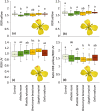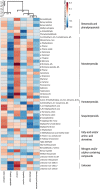Floral plasticity: Herbivore-species-specific-induced changes in flower traits with contrasting effects on pollinator visitation
- PMID: 30659631
- PMCID: PMC6850075
- DOI: 10.1111/pce.13520
Floral plasticity: Herbivore-species-specific-induced changes in flower traits with contrasting effects on pollinator visitation
Abstract
Plant phenotypic plasticity in response to antagonists can affect other community members such as mutualists, conferring potential ecological costs associated with inducible plant defence. For flowering plants, induction of defences to deal with herbivores can lead to disruption of plant-pollinator interactions. Current knowledge on the full extent of herbivore-induced changes in flower traits is limited, and we know little about specificity of induction of flower traits and specificity of effect on flower visitors. We exposed flowering Brassica nigra plants to six insect herbivore species and recorded changes in flower traits (flower abundance, morphology, colour, volatile emission, nectar quantity, and pollen quantity and size) and the behaviour of two pollinating insects. Our results show that herbivory can affect multiple flower traits and pollinator behaviour. Most plastic floral traits were flower morphology, colour, the composition of the volatile blend, and nectar production. Herbivore-induced changes in flower traits resulted in positive, negative, or neutral effects on pollinator behaviour. Effects on flower traits and pollinator behaviour were herbivore species-specific. Flowers show extensive plasticity in response to antagonist herbivores, with contrasting effects on mutualist pollinators. Antagonists can potentially act as agents of selection on flower traits and plant reproduction via plant-mediated interactions with mutualists.
Keywords: Brassica nigra (black mustard); flower colour; flower morphology; flower rewards; flower volatiles; herbivore-induced plant responses; phenotypic plasticity; plant defence; plant-mediated interactions; specificity.
© 2019 The Authors Plant, Cell & Environment Published by John Wiley & Sons Ltd.
Figures




Similar articles
-
The effects of herbivore-induced plant volatiles on interactions between plants and flower-visiting insects.Phytochemistry. 2011 Sep;72(13):1647-54. doi: 10.1016/j.phytochem.2011.03.013. Epub 2011 Apr 15. Phytochemistry. 2011. PMID: 21497866 Review.
-
Folivory affects composition of nectar, floral odor and modifies pollinator behavior.J Chem Ecol. 2014 Jan;40(1):39-49. doi: 10.1007/s10886-013-0369-x. Epub 2013 Dec 7. J Chem Ecol. 2014. PMID: 24317664
-
Plant ontogeny determines strength and associated plant fitness consequences of plant-mediated interactions between herbivores and flower visitors.J Ecol. 2020 May;108(3):1046-1060. doi: 10.1111/1365-2745.13370. Epub 2020 Apr 4. J Ecol. 2020. PMID: 32421019 Free PMC article.
-
Attracting mutualists and antagonists: plant trait variation explains the distribution of specialist floral herbivores and pollinators on crops and wild gourds.Am J Bot. 2014 Aug;101(8):1314-22. doi: 10.3732/ajb.1400171. Epub 2014 Aug 15. Am J Bot. 2014. PMID: 25156980
-
Lingering Effects of Herbivory and Plant Defenses on Pollinators.Curr Biol. 2018 Oct 8;28(19):R1164-R1169. doi: 10.1016/j.cub.2018.08.010. Curr Biol. 2018. PMID: 30300606 Review.
Cited by
-
Seed treatment with clothianidin induces changes in plant metabolism and alters pollinator foraging preferences.Ecotoxicology. 2023 Dec;32(10):1247-1256. doi: 10.1007/s10646-023-02720-0. Epub 2023 Dec 7. Ecotoxicology. 2023. PMID: 38062283 Free PMC article.
-
Mutualist- and antagonist-mediated selection contribute to trait diversification of flowers.PeerJ. 2022 Sep 29;10:e14107. doi: 10.7717/peerj.14107. eCollection 2022. PeerJ. 2022. PMID: 36196403 Free PMC article. Review.
-
Evolutionary Ecology of Plant-Arthropod Interactions in Light of the "Omics" Sciences: A Broad Guide.Front Plant Sci. 2022 Apr 25;13:808427. doi: 10.3389/fpls.2022.808427. eCollection 2022. Front Plant Sci. 2022. PMID: 35548276 Free PMC article. Review.
-
Bee-pollination promotes rapid divergent evolution in plants growing in different soils.Nat Commun. 2024 Mar 27;15(1):2703. doi: 10.1038/s41467-024-46841-4. Nat Commun. 2024. PMID: 38538597 Free PMC article.
-
Multiple Attack to Inflorescences of an Annual Plant Does Not Interfere with the Attraction of Parasitoids and Pollinators.J Chem Ecol. 2021 Feb;47(2):175-191. doi: 10.1007/s10886-020-01239-6. Epub 2021 Jan 28. J Chem Ecol. 2021. PMID: 33507456 Free PMC article.
References
-
- Adams, R. P. (1995). Identification of essential oil components by gas chromatography/mass spectrometry (4th ed.). Carol Stream: Allurum Publishing Corporation.
-
- Agrawal, A. A. (2011). Current trends in the evolutionary ecology of plant defence. Functional Ecology, 25, 420–432. 10.1111/j.1365-2435.2010.01796.x - DOI
Publication types
MeSH terms
Substances
LinkOut - more resources
Full Text Sources

